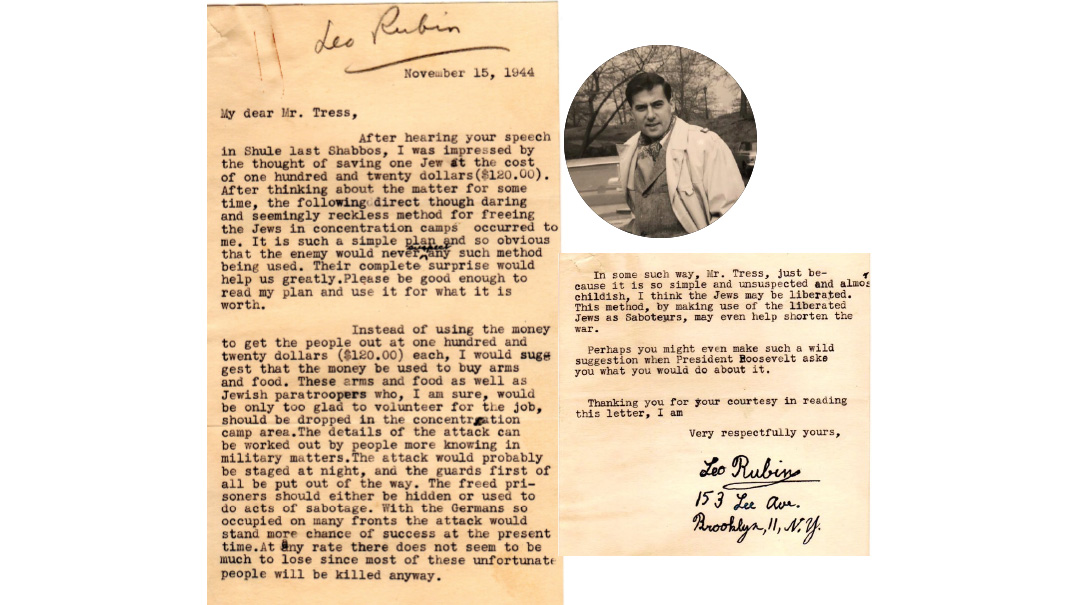They Called Upon Mike
| July 19, 2022Despite the frustration and the lack of a sense of accomplishment, Mike Tress continued tirelessly in his efforts at fundraising and rescue

Title: They Called Upon Mike
Location: Williamsburg, Brooklyn
Document: Letter
Time: November 15, 1944
Following the shock of Kristallnacht in November 1938, Mike Tress of Zeirei Agudath Israel established the Refugee and Immigration Division of Zeirei, which dealt with Jewish refugees of all stripes fleeing Nazi Germany and Austria, even prior to the war’s outbreak in 1939. For over four years, from 1938 to 1942, Mike Tress and Zeirei obtained visas, filed immigration applications, procured affidavits, lobbied the State Department, and assisted the few who succeeded in arriving in the United States.
On June 22, 1941, Nazi Germany invaded the Soviet Union with Operation Barbarossa, and began murdering the Jewish population within those territories en masse. Toward the end of that year, the Nazi leadership decided to implement the Final Solution, the total extermination of the Jews of Europe. Late 1941 and early 1942 saw the establishment of gas chambers at the death camps of Chelmno near Lodz, Belzec, Sobibor, and Treblinka in eastern Poland, and Operation Reinhard — the deportation of Polish Jewry to the death camps — was launched in the spring. By the end of the year, most Jews in the occupied Soviet Union and Poland had been murdered.
By September 1942, Mike Tress began to hear about the mass murders in the east from his World Agudath Israel channels of information. This was corroborated in December, with the announcement by Poland’s government in exile in London that a mass extermination of Polish Jews was taking place. In reaction to the devastating news, Mike Tress shifted gears from visas and affidavits to more ambitious and bold rescue operations. By late 1944, various schemes, including bribing Nazi officials to spare Jewish lives, were proposed in ever more desperate attempts at saving at least some of the helpless victims.
Mike Tress engaged in prodigious fundraising efforts, funneling desperately needed funds through the recently established War Refugee Board, and through his own contacts such as Isaac and Recha Sternbuch in Switzerland. Though the majority of these ransom attempts didn’t materialize, there were rare exceptions. In one notable instance, 1,200 Jews were released from Theresienstadt in the final months of the war as a result of negotiations. Despite the frustration and the lack of a sense of accomplishment, Mike Tress continued tirelessly in his efforts at fundraising and rescue.
In November 1944, he received a letter from Leo Rubin, a 15-year-old resident of Williamsburg and a student at Torah Vodaath who had arrived in the country just two years prior — following a miraculous escape from Europe. The letter included the suggestion of air-dropping arms, food, and Jewish paratroopers into concentration camps. The paratroopers would then overpower the SS guards and the newly freed inmates would engage in sabotage behind the lines, thus shortening the war as an added benefit. Though in hindsight the idea seems far-fetched, in the context of the time, any desperate measure may have seemed plausible and worth pursuing if it meant that more Jewish lives could be saved.
Unsurprisingly, young Leo seems to have assumed that Tress had regular contact with President Roosevelt. That unfortunately was not the case, as the president declined to meet with rescue activists throughout the war, though Tress did meet First Lady Eleanor Roosevelt and implored her to influence her husband to assist in rescue efforts.
Plucked from the Ashes
Leo Rubin was hardly just another student in Torah Vodaath in the 1940s. Born in 1929 in Vienna, he had witnessed Anschluss and the horrors of Kristallnacht when his father’s hardware business was destroyed. The family fled across Europe, eventually hiding on a farm in the south of France for nearly two years — with Leo celebrating his bar mitzvah in a barn. With the heroics of their Uncle Simon, who had arrived in America a short time earlier, and the assistance of an activist lawyer named Joel Gross, they were able to procure visas and come to America — where they settled in Williamsburg.
To Bomb or Not to Bomb
Much has been made of the alleged missed opportunity by the Allied air forces to bomb the crematoriums or the railroad tracks leading to Auschwitz. Recently declassified documents from the War Refugee Board archives show that the World Jewish Congress advised the Roosevelt administration that given the impossibility of precision bombing in World War II era planes, it was best not to bomb Auschwitz, lest the Germans claim it was the Allies who killed Jews there. Instead they suggested a plan similar to Leo Rubin’s — to utilize nearby underground forces and Russian paratroopers to destroy the camp.
Thank you to Sruly Tress and Moshe Tress, as well as to Moshe Rubin and Sabrina Silverman for their assistance tracking down Leo Rubin a”h and sharing the inspiring story of his life.
(Originally featured in Mishpacha, Issue 920)
Oops! We could not locate your form.






